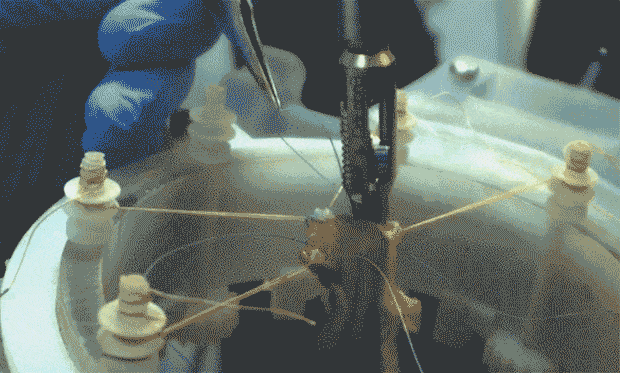
What's New
Autonomous Robot Surgeon Bests Humans in World First
By Eliza Strickland
Posted 4 May 2016 | 18:17 GMT
In a robotic surgery breakthrough, a bot stitched up a pig’s small intestines using its own vision, tools, and intelligence to carry out the procedure. What’s more, the Smart Tissue Autonomous Robot (STAR) did a better job on the operation than human surgeons who were given the same task.
STAR’s inventors don’t claim that robots can replace humans in the operating room anytime soon. Instead they see the accomplishment as a proof of concept—both for the specific technologies used and for the general concept of “supervised autonomy” in the OR.
Pediatric surgeon Peter Kim, one of the researchers, didn’t sound threatened when he spoke to reporters in a press call yesterday. “Even though we surgeons take pride in our craft at doing procedures, to have a machine that works with us to improve outcomes and safety would be a tremendous benefit,” he said.
Tiny ultrasound-powered motes could record and adjust nerve activity
By Eliza Strickland
Posted 21 Oct 2016 | 15:00 GMT
Mainstream medicine is making increasing use of electronics inside the body, deploying implanted gadgets both to measure internal conditions and to provide stimulating jolts of electricity to nerves and muscles. But turning a human into a proper cyborg will require many minuscule devices that can be scattered throughout the body. As a step toward that goal, a team of bioengineers has built speck-size wireless electrodes that can be affixed directly to nerves—and that may one day be nestled inside the brain.
The engineers from the University of California, Berkeley, implanted one mote of what they call “neural dust” inside an anesthetized rat, and demonstrated that the electrode could record signals from the rat’s sciatic nerve and wirelessly transmit the information. This experiment was a proof of concept, says Jose Carmena, who co-led the research at UC Berkeley’s Center for Neural Engineering and Prostheses, where he is codirector. If the neural dust can be adapted for the human body and brain, doctors could have an intimate new interface with the human nervous system.


For this study, published today in the journal Science Translational Medicine, researchers programmed their robot to carry out a procedure called intestinal anastomosis, in which a piece of intestine that’s been cut through is stitched back together. It’s like repairing a garden hose, said Ryan Decker, the senior engineer on the team, in that the sutures must be tight and regularly spaced to prevent leaks. STAR performed this task both on ex vivo tissue in the lab and on in vivo tissue in an anesthetized pig, and experienced human surgeons were given the same tasks. When the resulting sutures were compared, STAR’s stitches were more consistent and more resistant to leaks.
The robot did have a little help. In about 40 percent of its trials, the researchers intervened to offer guidance of some sort—as in the GIF above, where a human hand is seen holding the thread. In the other 60 percent of trials, STAR did the job completely on its own.
But first, it had to work in a conked-out rat.
To power the neural dust, a transducer outside the animal’s body emits ultrasound vibrations that pass through skin and tissue. When the sound waves reach the implanted mote, its piezoelectric crystal converts the vibrations’ mechanical energy into electricity, providing power to a tiny transistor pressing against the nerve. As natural electrical activity in the nerve varies, it changes the current passing through the transistor, thus providing a read-out mechanism for the nerve’s signal.
To send the information back out of the body, the neural dust system also uses ultrasound. The external transducer alternates between sending ultrasound vibrations to power the mote and listening for the returning echo as some of those vibrations bounce back. The changing current through the transistor alters the piezo crystal’s mechanical impedance, thereby modulating how much bounce back the transducer receives.
